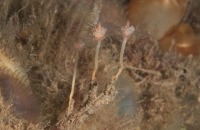
(Photo: Claire Goodwin)
Pink Heart Hydroid
Ectopleura crocea
Colonies are in the form of bushy clusters of polyps up to 15 centimetres in diameter. Polyps resemble flowers and are attached to the stem at the lower end, while the upper end (hydranth) has a mouth surrounded by tentacles. Polyp stems are up to two centimetres long and the pink to red hydranth "flowers" are up to one centimetre in diameter.
Authority
Agassiz, 1862
Classification Details
Phylum: Cnidaria (Cnidarians); Class: Hydrozoa (hydrozoans).
Habitat
Found from the low intertidal down to 40 metres. Attaches to hard substrates such as rocks, mussel shells, and man-made structures such as docks. Native to the Atlantic Ocean where it occurs from New Brunswick to Florida. This species was also introduced to the Pacific on ship’s hulls.
Diet
Polyps stun their prey using stinging cells called nematocycts on their tentacles. They feed on zooplankton such as copepods, mysid shrimps, and arrow worms.
Reproduction
Each colony of polyps is male or female. Sperm are released from male polyps into the water and then swim to eggs in the reproductive structures of female polyps. Larvae develop in the female polyps, then spend a short period in the water column before settling on the nearby seabed. Polyps can also reproduce asexually – new hydranths can grow from stolons at the base of the polyp.
Fun Facts
Several species of sea slug (nudibranch) feed on this hydroid. Some of these sea slugs can take the hydroid’s stinging cells (nematocysts) and store them in their own skin to protect them against predators.
References
Fogg-Matarese S (2009) The use of cnidarian nematocysts by the aeolidian nudibranch Cratena pilata. Dissertations and Master’s Theses (Campus Access). Paper AAI3380534. https://digitalcommons.uri.edu/dissertations/AAI3380534
Martinez AJ (2019) Marine life north Atlantic. Digital application http://marinelifeofthenorthatlantic.com/ Accessed online 20 January 2020.
Rudy P and Rudy LH (1983) Ectopleura crocea. Oregon Estuarine Invertebrates: An Illustrated guide to the common and important invertebrate animals. National Coastal Ecosystems Team: Oregon. Available from http://hdl.handle.net/1794/1070.


